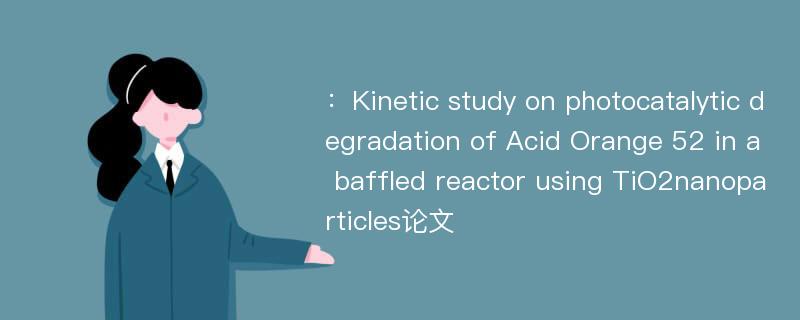
本文主要研究内容
作者(2019)在《Kinetic study on photocatalytic degradation of Acid Orange 52 in a baffled reactor using TiO2nanoparticles》一文中研究指出:In this study, a baffled photocatalytic reactor was used for the treatment of colored wastewater containing the azo dye of Acid Orange 52(AO52). A study on the active species of the photocatalytic process using TiO2 nanoparticles indicated that hydroxyl radical and superoxide have the greatest contribution to the dye degradation process respectively.Given that a level of biological oxygen demand/chemical oxygen demand(BOD5/COD) equal to 0.4 was achieved after about 5 hr from the beginning of the experiment, the reactor seems to be capable of purifying the wastewater containing AO52 dye after this time in order to discharge into a biological treatment system to continue the treatment process.The results of the liquid chromatography-mass spectrometry(LC-MS) test showed that during the first 4 hr of the experiment, with the breakdown of the azo bond, the contaminant was decomposed into the benzene annular compounds with less toxicity indicating a reduction in the toxicity of wastewater after removing the dye agent. The study on the kinetics of these reactions followed the pseudo-first-order kinetic model in all conditions and corresponded well to Langmuir–Hinshelwood model. According to the kinetic model for the simultaneous occurrence of possible pathways, the kinetic constant of production and degradation of intermediate products in optimal conditions was estimated to be between 0.0029 and 0.0391 min-1.
Abstract
In this study, a baffled photocatalytic reactor was used for the treatment of colored wastewater containing the azo dye of Acid Orange 52(AO52). A study on the active species of the photocatalytic process using TiO2 nanoparticles indicated that hydroxyl radical and superoxide have the greatest contribution to the dye degradation process respectively.Given that a level of biological oxygen demand/chemical oxygen demand(BOD5/COD) equal to 0.4 was achieved after about 5 hr from the beginning of the experiment, the reactor seems to be capable of purifying the wastewater containing AO52 dye after this time in order to discharge into a biological treatment system to continue the treatment process.The results of the liquid chromatography-mass spectrometry(LC-MS) test showed that during the first 4 hr of the experiment, with the breakdown of the azo bond, the contaminant was decomposed into the benzene annular compounds with less toxicity indicating a reduction in the toxicity of wastewater after removing the dye agent. The study on the kinetics of these reactions followed the pseudo-first-order kinetic model in all conditions and corresponded well to Langmuir–Hinshelwood model. According to the kinetic model for the simultaneous occurrence of possible pathways, the kinetic constant of production and degradation of intermediate products in optimal conditions was estimated to be between 0.0029 and 0.0391 min-1.
论文参考文献
论文详细介绍
论文作者分别是来自Journal of Environmental Sciences的,发表于刊物Journal of Environmental Sciences2019年05期论文,是一篇关于,Journal of Environmental Sciences2019年05期论文的文章。本文可供学术参考使用,各位学者可以免费参考阅读下载,文章观点不代表本站观点,资料来自Journal of Environmental Sciences2019年05期论文网站,若本站收录的文献无意侵犯了您的著作版权,请联系我们删除。
